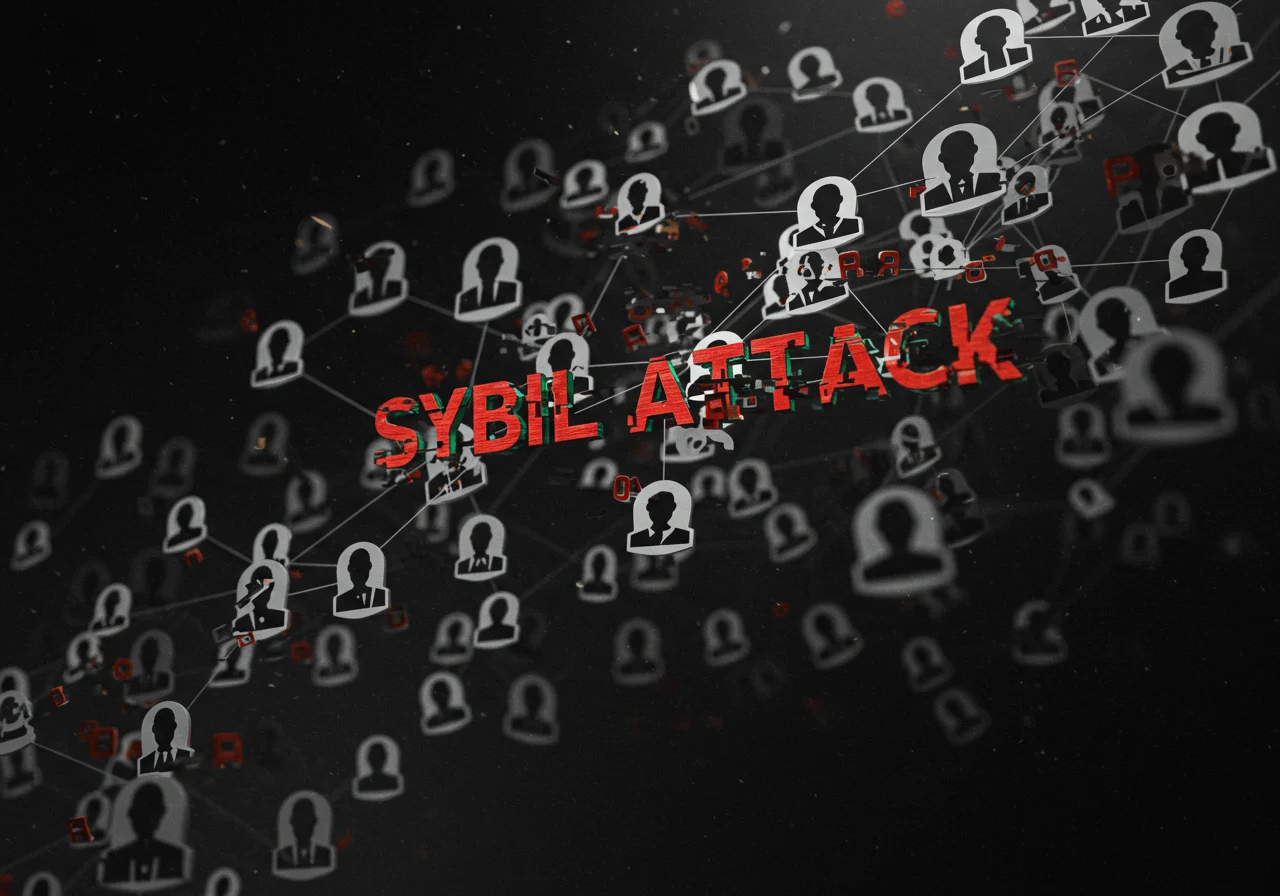Sybil Attacks Explained: How to Spot Fake Accounts on Crypto Networks
Table of Contents
I want you to imagine someone at a town fair handing out dozens of flyers that all say the same thing. At first you think many people support that idea. Later you learn one person printed all the flyers and pretended to be a crowd. That feeling—of being fooled by numbers—is at the heart of Sybil Attacks.
Sybil Attacks are about faking presence. They happen when one actor creates many identities to appear as many. On the internet, numbers often mean influence. In crypto, numbers can mean voting power, reputation, or liquidity. If one person fakes many accounts, they can sway decisions, manipulate markets, or hide fraud. That is why learning how to spot fake accounts matters.
What are Sybil Attacks and why they matter

A Sybil Attack happens when an attacker makes many false identities. The attacker uses these identities to act like a crowd. On crypto networks, this can let them:
- Pretend many users back a proposal.
- Fill a liquidity pool to fake demand.
- Create fake reviews or reputations.
- Launch coordinated scams while hiding behind many accounts.
Crypto networks often rely on community votes, reputation scores, or token-weighted decisions. That makes identifying Sybil attacks a core security task. When the network trusts counts of accounts or votes, fake identities can bend the outcome.
A simple example
Think about a small online vote deciding which project gets funding. If one person controls 100 fake accounts, they can vote 100 times. The vote becomes meaningless. That single act can cost real people money or trust.
How attackers create fake accounts
Attackers use many methods:
- Automated scripts to open many accounts quickly.
- Cheap phone numbers or email services to pass basic checks.
- Stolen or rented identities from data breaches.
- Buying pre-made accounts that look aged and real.
Some fake accounts are obvious. Others are made carefully to look real: they show a bit of activity, they interact with real users, or they hold tiny amounts of tokens. These are the hardest to spot.
Ways Sybil Attacks harm crypto networks

The harms are practical and serious:
- Manipulating governance: Fake votes can push through harmful protocol changes.
- Economic manipulation: False liquidity or fake trades can inflate prices.
- Trust erosion: If users think a community is fake, they leave.
- Scams and laundering: Attackers use fake accounts to create fog, making scams harder to trace.
Crypto communities value honesty and openness. Preventing fraudulent activity keeps those values intact. Knowing the risks helps protect your money and your community.
How to spot fake accounts — everyday checks
You don’t need advanced tools to look for red flags. Here are practical signs that help with detecting fake accounts:
- New account with sudden heavy activity
If an account is days old and suddenly posts lots of content or votes heavily, be cautious. - Identical messages across accounts
Fake accounts often repeat the same phrases. Look for copy-paste patterns. - Low interaction from real users
Accounts that only interact with a small, closed group may be part of a Sybil cluster. - Too-uniform profile details
Similar usernames, profile avatars, or bios across several accounts is suspicious. - Strange transaction patterns
Accounts that move tiny amounts in a circle, or funnel tokens to one address, may be coordinating. - Unnatural timing
Many accounts acting at the exact same time often indicate automation. - High vote activity without real discussions
If accounts vote but never participate in meaningful conversation, they may be fake.
Use these checks as simple filters. They aren’t final proof but they point to suspicious behavior worth reporting.
Practical tip: cross-check on-chain and off-chain
A helpful step is to check both the blockchain and social platforms. For example, if a wallet appears to be a big supporter on a governance forum, look at the on-chain transaction history. Does the wallet show real, varied transactions? Does the social profile have genuine interactions? This cross-check helps spot Sybil Attacks that hide in plain sight.
Tools and methods networks use to reduce Sybil risk

Crypto projects use technical and social methods to fight Sybil attacks. Here are common blockchain authentication methods and practices:
- Proof-of-Work (PoW) and Proof-of-Stake (PoS)
These systems weight influence by work or stake. In PoS, owning tokens gives voting power. PoS reduces identity-only attacks because attackers need real funds or resources. - KYC (Know Your Customer) for sensitive actions
Requiring identity checks for certain operations raises the bar for attackers. This is common in regulated exchanges but less so in open networks. - Rate-limits and CAPTCHA
Simple, but effective: limit how fast new accounts can act, and use CAPTCHAs to block automated sign-ups. - Reputation systems with decay
Make reputation grow slowly and require sustained activity. That makes it expensive to fake influence quickly. - Social-graph analysis
Detect clusters of accounts that interact only with one another. These clusters often signal Sybil groups. - Stake-based or token-locked voting
Making votes require locking tokens reduces the benefit of fake accounts. The attacker must put real value at risk. - Decentralized identity protocols
Tools like DID (Decentralized Identifiers) and verifiable credentials can tie actions to accountable identities without revealing private data.
Each method has trade-offs. Heavy ID checks improve security but reduce privacy. Stake-based systems protect governance but favor rich users. The right balance depends on the project’s values.
How communities and users can prevent fraud
Security is shared. Users, developers, and moderators all play a role in preventing fraudulent activity.
- Report suspicious clusters: Report accounts that show repeated red flags. Moderators can block or investigate.
- Favor long-term activity: In votes or airdrops, prefer users with sustained participation.
- Use multi-factor verification: Encourage two-factor authentication for accounts with power.
- Set meaningful participation requirements: Require some time or interactions before an account can vote or access big rewards.
- Educate users: Teach community members to spot social-engineering and bot signs.
- Open audits: Allow third parties to analyze network data and publish findings.
A small, active community with clear rules is often the best defense.
When machine learning helps — and when it fails
Advanced projects use machine learning to detect Sybil patterns. ML can spot subtle transaction clustering or unusual text patterns. But ML has limits:
- It can make mistakes and flag real users.
- Attackers adapt, changing techniques faster than models.
- ML needs good labeled data to learn what is malicious.
So ML is a tool, not a cure. Combine it with good moderation and transparent policies.
Governance designs that reduce Sybil influence
Some networks design governance to be Sybil-resistant by default:
- Quadratic voting: Reduces influence of many small votes.
- Reputation-weighted systems: Reputation grows with sustained contribution, not quick account creation.
- Hybrid models: Combine stake, reputation, and identity proofs to balance fairness and security.
Smart governance recognizes that no single metric is perfect. Mixing measures helps.
Practical checklist for network users
If you run or participate in a crypto community, here is a short checklist to strengthen security and help with identifying Sybil attacks:
- Require short probation before new accounts can vote.
- Limit mass account creation from same IP ranges.
- Monitor for identical messages or timing patterns.
- Encourage use of verified wallets or social proofs.
- Keep moderation logs transparent to build trust.
These steps reduce attackers’ leverage and protect genuine users.
Conclusion — stay curious, stay cautious
Sybil Attacks are a reminder that numbers alone are not proof of trust. Fake accounts can sway systems built on counts and votes. But awareness helps. By learning to spot red flags, using tools that raise the bar for attackers, and designing governance with Sybil resistance in mind, communities can protect themselves.
Security is a shared practice. When everyone watches for the signs—simple ones like identical messages or odd transaction loops, and deeper ones like clustered social behavior—networks become safer. Small actions, like reporting a suspicious account, matter.
Quick takeaways
- Sybil Attacks involve one actor creating many fake identities to appear as many.
- Watch for red flags: new accounts with sudden activity, copy-paste messages, and clustered transactions.
- Use mixed defenses: blockchain authentication methods, reputation systems, stake-based voting, and rate-limits.
- Machine learning can help detect patterns but must be paired with human review.
- Community practices—education, reporting, and transparent moderation—are vital in preventing fraudulent activity.
- Balance privacy and security: stronger identity checks mean more safety but less anonymity.
FAQ
Q: Can a single person really cause damage with fake accounts?
A: Yes. In governance votes, liquidity pools, or reputation systems, one actor with many accounts can change outcomes and harm real users.
Q: Are all bots malicious?
A: No. Some bots provide useful services like price alerts or automated market making. The problem is when bots are used to deceive.
Q: How can ordinary users help?
A: Report suspicious accounts, avoid engaging with clear bot messages, and support projects that use fair governance and security checks.
Q: Will requiring ID stop Sybil Attacks?
A: ID checks raise the cost of attack but reduce privacy. They help in regulated contexts but are not always suitable for open, permissionless projects.
Q: Is there a perfect solution?
A: No. Sybil resistance involves trade-offs. The best approach mixes technical measures, good governance design, and active community moderation.

Hello, I’m Edmilson Dias, founder of CoinBringer. I created this platform to guide people through the fast-moving world of cryptocurrency with clarity and safety. With years of research in blockchain and digital security, my goal is to translate complex topics into practical knowledge, offering reliable tutorials, safety insights, and guidance for both newcomers and experienced users.
Discover more from CoinBringer
Subscribe to get the latest posts sent to your email.







